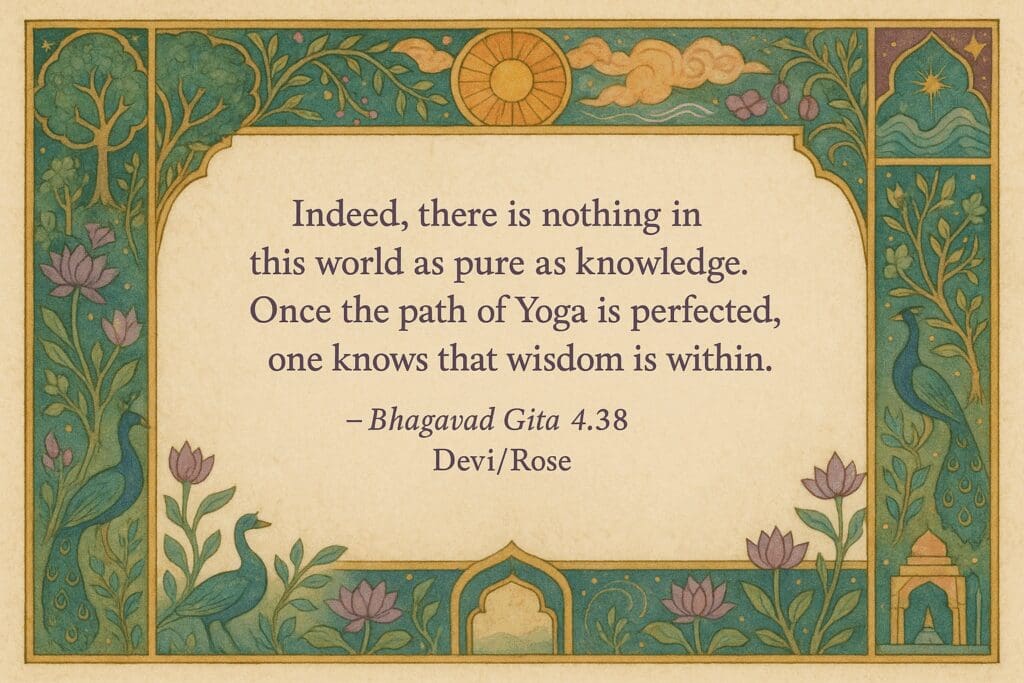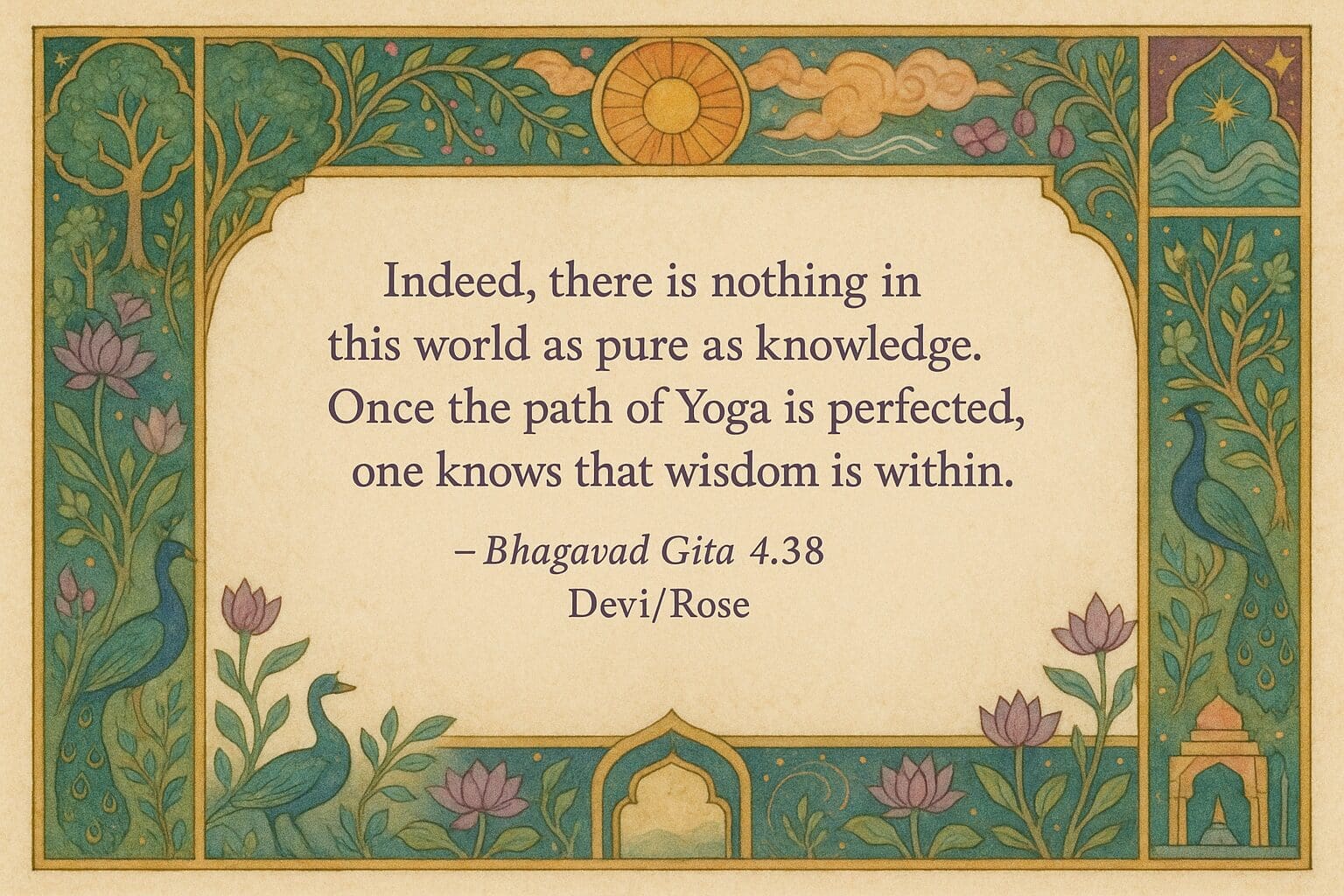Reclaiming Women’s Voices in Yoga Philosophy
This blog post emerges from a recent talk I gave as part of “A Woman’s Gita” podcast, created in partnership with my co-host Nischala Joy Devi and supported by Yoga Gives Back—an international community of yoga teachers who donate classes to uplift women and children in India as gratitude for the gift of yoga.
Welcome to my first blog post. I’m Kamala Rose, and I want to share why I’ve devoted my life to yoga, and why I believe women’s voices are essential to the future of yoga philosophy. My teaching focus for many years has been on the Bhagavad Gita as I see it as a meeting place where the essential idea of Eastern worldviews can be discussed and made meaningful in our modern lives.
Finding My Voice in Ancient Wisdom
My journey with the Bhagavad Gita began in an unexpected way. As a blonde kid from the Midwest, India seemed impossibly distant until my father’s academic work brought my family to India and Krishna into our home. His research on Max Mueller’s translation of the Upanishads, inspired by a flash of insight during a flight home from India, introduced me to a world where mystical knowledge was real and accessible. That same trip included a meeting with Indira Gandhi – a moment that imprinted the power of India, and Krishna, on my young consciousness.
This early exposure led me to spend thirty years in an ashram, diving deep into the Gita and the spiritual psychology that accompanies it. I’ve studied with traditional Sanskrit teachers, including Mr. Ramaswami of Krishnamacharya’s lineage, and explored the text through various academic institutions. Yet even with all this experience and support, I still found myself doubting my voice when it came to sharing these ancient teachings.
And therein lies the heart of why we need a feminine interpretation of the Gita.
The Courage to Act: Beyond the Fruits of Action
One of the verses we most wrestle with in the Gita speaks directly to this challenge:
“You have a right to action, but not to the fruits of action. Let not the fruit of action be your motive, nor let your attachment be to inaction.” (2.47, Devi/Rose)
This verse forces us to ask the hardest questions: What is your motive? What’s the why behind your action? In our transactional, capitalist society, we expect rewards for our efforts. But as yogis, we must have the courage to practice satya – honesty – about our true motivations.
For women, this verse carries particular weight. Why do we hold back our voices? Why do we feel timid about expressing ourselves, especially around spiritual or religious ideas? The answer lies partly in our societal conditioning. Our voices are often not heard in spirituality, just as they’re not heard in many other spheres. This silencing makes us hesitant to speak about our understanding of yoga, worried that our personal comprehension might be too shallow to speak confidently on such profound subjects.
But the verse also warns against attachment to inaction. By not doing something, are we avoiding out of fear? For women, there’s deep psychology here – we become habituated to not speaking our voices, creating a different kind of attachment that comes from the same place as attachment to results.
The Gita speaks of sattvic action in karma yoga: do what needs to be done, not what you want to do or what will make you look good. I believe this is a perspective that women can uniquely bring to spiritual dialogue – understanding necessary action, not ego-driven action.
The Purity of Inner Knowledge
Another profound verse speaks to the nature of spiritual wisdom:
“Indeed, there is nothing in this world as pure as knowledge. Once the path of Yoga is perfected, one knows that wisdom is within.” (4.38, Devi/Rose)
Here, Krishna speaks of jnana—mystical knowledge and insight. This isn’t knowledge of how to fix a car or build a website, valuable though those skills are. This is transcendent, revelatory knowledge that comes like Einstein’s flash of insight about light, “like a raindrop or a birdsong” dropping into consciousness.
I remember my father’s story of his dissertation insight – how the whole picture came to him “like a drop of water in his mind” while flying home from India. He used words like “epiphany,” and “satori.” That’s the kind of knowing yoga offers: insight about Reality, about oneself as a spiritual being, about the essence that exists within us and connects us to everything.
The path of wisdom requires shraddha – faith. In our modern era, we struggle to put faith in concepts like Krishna or Brahman, foreign as they may seem to Western minds. We often seek external validation—association with charismatic individuals or certain certifications—to prove our knowledge. But yoga asks for a different kind of knowing, beyond degrees and approval.
This requires faith in the tradition itself, in a path that has guided generations of practitioners through the eightfold path from ethics to samadhi. As yoga practitioners, we can put faith in this tradition beyond any personality or certification. Then comes the courage to trust our own experience.
Traditional translations often say “he who is perfected in wisdom.” When we read this as women, it’s easy to exclude ourselves. But when we understand it as “one who knows the wisdom within,” the path opens for all of us – which is a fundamental strength of the Gita. It declares that everyone can know this wisdom; gender makes no difference.
Most men I know in the yoga community are strong and intuitive enough to recognize how women see the world differently and would benefit from greater peer discussion to make yoga theory more practical.
Claiming Our Authority in a Post-Lineage World
After spending decades studying the Gita and sitting with traditional teachers, I still doubted my voice. Even when recording our podcast, I questioned whether I knew enough, whether my knowledge was perfect enough to present this subject. But there is no perfect – you can’t know everything about the Gita. At some point, you must trust what you know and recognize that this knowledge is valuable to others.
This connects to what researcher Theodora Wildcroft calls “post-lineage” yoga. Through her doctoral fieldwork in the yoga community, she observed how modern yoga teachers absorb and share knowledge in collective spaces like studios, trainings, and festivals. She uses the image of spreading mycelium, supporting each other like a forest’s underground web. This organic, interconnected network stands in stark contrast to the conventional vertical lineages of traditional yoga – the father-to-son transmissions that move knowledge downward through hierarchical structures. Where traditional lineage resembles a family tree with clear branches and succession, post-lineage yoga functions more like the hidden fungal networks that connect entire forests, sharing resources and wisdom horizontally, peer to peer, in ways that are less visible but perhaps more resilient.
I suggest we need both, like a healthy forest. The deep roots of traditional lineage provide stability and connection to ancient wisdom, while the mycelial networks allow for adaptation, cross-pollination of ideas, and the kind of collaborative learning that can help yoga philosophy evolve to meet our modern needs.
This resonates deeply with my own journey. I’ve studied with the Theosophical Society, explored traditional Indian worldviews, embraced systems theory, and engaged with academic approaches that leave no room for intuitive knowledge. We’re often combinations of multiple influences, and that’s not a weakness – it’s an evolution.
Yet spirituality and religion remain areas where women are terribly underrepresented, despite these fields centering on interior knowing – something women often navigate intuitively. Today, women make up over 80% of the yoga community. We’re the ones doing yoga, teaching yoga—but we’re still primarily learning from men, quoting men, studying texts featuring only men.
Setting the Standard: The Great Person’s Example
The Gita tells us:
“A great person’s actions inspire others who follow by example. Setting the standard, others follow.” (3.21, Devi/Rose)
We’re living in a time when we desperately need new standards, ones not established by charismatic but flawed personalities, or by an inconsistent certification process that underrepresents practice beyond asana. This may mean supplemental training, mentorships, and community gatherings that emphasize continuing education.
Women’s voices are a powerful part of the dialogue about the future we’re shaping together. As yoga teachers, especially women, we must embrace and embody the role we’ve stepped into. We must let ourselves be part of the tradition we represent, allow our voices to be heard, and claim our own understanding of these verses. Finding practical ways to relate to the teachings on a consistent basis is what the Gita does best – it can be a crossroads of new ideas when most needed.
Why do we look at heroes winning wars as the model of righteousness? What about the people quietly feeding everyone, seeking no praise or recognition? Why isn’t the example of a mother who gives nine months of her life and body to gestate another human being, then feeds that person from her own body, considered the ultimate example of karma yoga and selflessness?
As women, we must consciously insert ourselves into this spiritual dialogue. The vital work of inspiring children to grow up as good people shapes future society – these are admirable acts fulfilled largely by women.
As more and more men are stepping into caregiving roles – for children, parents, partners – women’s perspectives may become a welcome addition to what is often dry and intellectual. It’s not an either/or – it’s a yes/and.
Living the Teaching
The Gita asks us to take this knowledge into our lives, into society, into the way we live and work. Don’t leave it in a dusty old book that you think you don’t understand. I challenge women in the yoga community: you understand more than you think. If you wrestle with getting in your own way or sometimes feel overwhelmed, you have insight into exactly what the Gita is discussing.
Taking time with texts like this is essential. You don’t need to know everything in a day, but you can understand key ideas very well and put them to work in your life. Take them off the page and carry them with you in your daily experience.
The Future of Women’s Spiritual Authority
Through “A Woman’s Gita” podcast and this blog, I’m exploring what it means to teach from your own voice—not from charisma or credentials, but from lived truth. We’re asking why so many women hesitate to share yoga wisdom, whether spiritual authority is evolving beyond institutions, and how women yoga teachers can claim their voices in this rich tradition.
This work reaches far beyond each of us as individuals. It empowers a community that is largely female. This is where we can stand up and claim our voices in the yoga tradition, trusting the wisdom that lives in our bones, the knowledge that comes from our direct experience with these ancient teachings.
If yoga is to survive as a fully integrated practice, with its beautiful teachings on the depth available to human beings, we must ensure that a greater percentage of yoga teachers are fluent in philosophy.
The voice within is worthy of trust. The wisdom you’ve cultivated through your practice, your life experience, your unique perspective as a woman—this is pure knowledge, as valuable as any traditional commentary. It’s time to let it be heard.
– Kamala Rose July 2025

